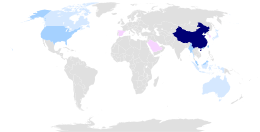
Standard Chinese
Standard form of Chinese and official language of China / From Wikipedia, the free encyclopedia
Dear Wikiwand AI, let's keep it short by simply answering these key questions:
Can you list the top facts and stats about Standard Chinese?
Summarize this article for a 10 year old
Standard Chinese (simplified Chinese: 现代标准汉语; traditional Chinese: 現代標準漢語; pinyin: Xiàndài biāozhǔn hànyǔ; lit. 'modern standard Han speech') is a modern standard form of Mandarin Chinese that was first codified during the republican era (1912‒1949). It is designated as the official language of mainland China and a major language in the United Nations, Singapore, and Taiwan. It is largely based on the Beijing dialect. Standard Chinese is a pluricentric language with local standards in mainland China, Taiwan and Singapore that mainly differ in their lexicon.[7] Hong Kong written Chinese, used for formal written communication in Hong Kong and Macau, is a form of Standard Chinese that is read aloud with the Cantonese reading of characters.
| Standard Chinese | |
|---|---|
| Standard Mandarin | |
| 现代标准汉语; 現代標準漢語 Xiàndài biāozhǔn hànyǔ | |
| Native to | Mainland China, Taiwan, Singapore |
Native speakers | Has begun acquiring native speakers (as of 1988);[1][2] L1 and L2 speakers: 80% of China[3] |
Sino-Tibetan
| |
Early forms | |
| Signed Chinese[4] | |
| Official status | |
Official language in |
|
| Regulated by |
|
| Language codes | |
| ISO 639-3 | – |
| ISO 639-6 | |
| Glottolog | None |
 Countries where Standard Chinese is spoken
Majority native language
Statutory or de facto national working language
More than 1,000,000 L1 and L2 speakers
More than 500,000 speakers
More than 100,000 speakers | |
| This article contains IPA phonetic symbols. Without proper rendering support, you may see question marks, boxes, or other symbols instead of Unicode characters. For an introductory guide on IPA symbols, see Help:IPA. | |
| Common name in mainland China | |||||||||||||||||
|---|---|---|---|---|---|---|---|---|---|---|---|---|---|---|---|---|---|
| Traditional Chinese | 普通話 | ||||||||||||||||
| Simplified Chinese | 普通话 | ||||||||||||||||
| Literal meaning | Common speech | ||||||||||||||||
| |||||||||||||||||
| Common name in Taiwan | |||||||||||||||||
| Traditional Chinese | 國語 | ||||||||||||||||
| Simplified Chinese | 国语 | ||||||||||||||||
| Literal meaning | National language | ||||||||||||||||
| |||||||||||||||||
| Common name in Singapore and Southeast Asia | |||||||||||||||||
| Traditional Chinese | 華語 | ||||||||||||||||
| Simplified Chinese | 华语 | ||||||||||||||||
| Literal meaning | Chinese language | ||||||||||||||||
| |||||||||||||||||
Like other Sinitic languages, Standard Chinese is a tonal language with topic-prominent organization and subject–verb–object (SVO) word order. Compared with southern varieties, the language has fewer vowels, final consonants and tones, but more initial consonants. It is an analytic language, albeit with many compound words.
In the context of linguistics, the dialect has been labeled Standard Northern Mandarin[8][9][10] or Standard Beijing Mandarin,[11][12] and in common speech simply Mandarin,[13] better qualified as Standard Mandarin, Modern Standard Mandarin or Standard Mandarin Chinese.